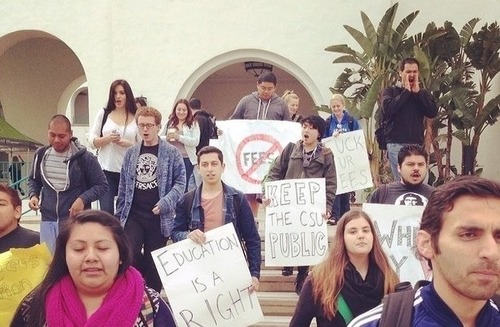 Students march to the SDSU president’s office. (Credit: Nadir Bouhmouch)
Students march to the SDSU president’s office. (Credit: Nadir Bouhmouch)
What’s the Matter With California? Student Dispatches From Santa Cruz to the Border
By James Cersonsky
(This post which was edited by Youngist contributor James Cersonsky, was originally published by The Nation and is republished here with permission.)
Contact studentmovement@thenation.com with any questions, tips or proposals. Edited by James Cersonsky (@cersonsky).
- As Napolitano Sits, Campus Occupations Spread
On March 5, as UCLA students died-in against deportations, #not1more continued to growand students at the largely working class Community College of San Francisco prepared further action against a potential shutdown, students at the University of California–Santa Cruz took up Berkeley’s call for escalating action against UC President and former Secretary of Homeland Security Janet Napolitano. Fresh off major wins for strike-ready UC service workers and Santa Cruz teaching assistants, students and workers rallied to make clear that these developments are part of a larger struggle to reclaim the university. After marching to McHenry Library, students entered the Hahn Student Services building and subsequently occupied it for eighteen hours. There, we called for Napolitano’s resignation and for workers’ ongoing demands—safer staffing, smaller classes and work for undocumented graduate students—to be met. Through daybreak on March 6, Hahn, normally a space of loans, fees and student-judicial affairs, became a site for students to strategize resistance to the dual challenges of racism and privatization.
— Autonomous Students
- As Cal State Tuition Skyrockets, Students Mass Across the State
California State University’s new tactic of adding “student success” fees on a campus-by-campus basis, a fee hike by any other name, is drawing criticism from students, faculty andeditorial boards on campus and off. For a week, students at San Diego State University have been trying to meet with their president—who gained statewide notoriety in 2011 when he was awarded a 30 percent raise at the same time that a fee hike was implemented—after arubber-stamp committee recommended fees be raised in fall 2014. Students have staged multiple sit-ins, marches and rallies on campus against the hike, decrying undemocratic decision-making and demanding a meeting with the president, who has yet to even respond to letters or e-mail via intermediaries. Leading up to the CSU Board of Trustees meeting on March 26, students at SDSU, Fullerton and Dominguez Hills, all affected by the fees, will continue building pressure.
— Bo Elder
- High Schoolers Rally Over Shutdown
In February, LA’s Roosevelt High School Academy of Environmental & Social Policy received a letter from Superintendent John Deasy directing this small and notably successful school to join a larger campus in a new neighborhood or close down. Despite four hours of protest by parents and students outside LAUSD headquarters on February 25, nine speakers who addressed the school board this week and questionable claims of fiscal unsustainability, the community has not been able to convince the district to reconsider this decision—made without any input from students, parents or staff. We are fighting for our school because it is safe, a place where we are involved and, most importantly, to assert the importance of student voice—which the district is quick to ignore.
—Gabriela Castaneda
- Who Speaks for Mass Incarceration?
This winter in West Philadelphia, FAAN Mail, a collective of young women of color, organized a screening and discussion of Orange Is the New Black, the Netflix series set in a women’s prison. Community members concerned about—and personally affected by—mass incarceration shared dialogue about the portrayal and realities of prison. Activists talked about local organizing efforts after exploring the following questions: What value, if any, doesOITNB offer in the movement to end mass incarceration? What aspects of the show are realistic or fantasy? What do OITNB audiences need to know about mass incarceration?
—FAAN Mail

